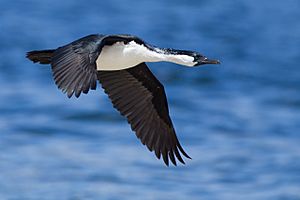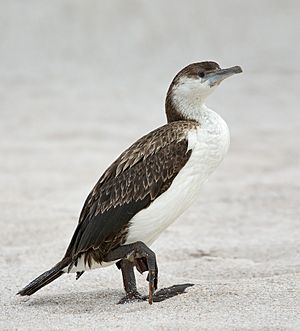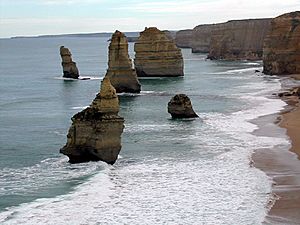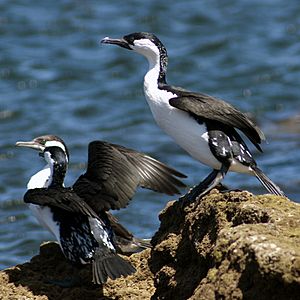Black-faced cormorant facts for kids
Quick facts for kids Black-faced cormorant |
|
|---|---|
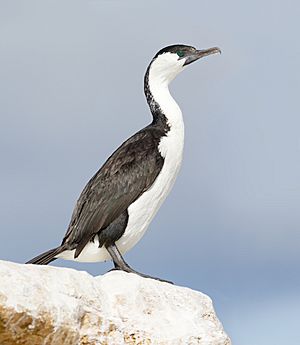 |
|
| Conservation status | |
| Scientific classification | |
| Genus: |
Phalacrocorax
|
| Species: |
fuscescens
|
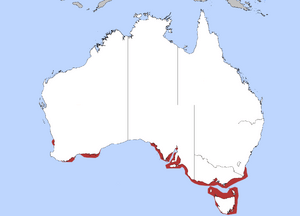 |
|
| Distribution of the black-faced cormorant | |
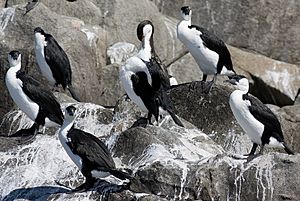
The black-faced cormorant (Phalacrocorax fuscescens), also called the black-faced shag, is a medium-sized bird. It belongs to the cormorant family. This bird has black feathers on its upper body, face, and beak. Its belly and chest are white. You can only find this bird along the coasts of southern Australia.
Contents
What Does It Look Like?
The black-faced cormorant is a large water bird. Like other cormorants, it has a long, hooked beak and webbed feet. Its feathers are mostly black and white. The top half of its body is black, and its underside is white.
Its face is bare and black, which is how it got its name. Its tail, feet, and thighs are also black. The feathers on its back look shiny. Its beak is dark grey and has a strong hook at the end. This bird has blue-green eyes. When it flies, it holds its head low. Its wings form a cross shape, like most cormorants.
Young Birds and Their Feathers
Young black-faced cormorants look a bit different. They have dark-brown feathers on their upper body. Their face is also dark. Their underside is lighter, with some brown streaks. As they grow older, their feathers become more like the adults.
How Does It Sound?
Black-faced cormorants are usually quiet. This is true when they are away from their nesting areas. But at their nests, the male bird makes a loud honking or croaking sound. The female bird will hiss if someone gets too close.
Where Does It Live?
Black-faced cormorants live only along the coasts of southern Australia. You can find them in Western Australia, South Australia, Victoria, and Tasmania. They are especially common in the Bass Strait and Spencer Gulf. There are tens of thousands of these birds.
Its Home
Unlike other cormorants in Australia, this bird lives only in coastal and ocean areas. You can find them in ocean waters, bays, and on rocky shores. They also live on islands off the coast. Sometimes, they visit estuaries where rivers meet the sea.
They build their nests on tall cliffs and rocky islands. These places keep them safe. In winter, they go to these colonies to breed.
What Does It Do?
The black-faced cormorant is a marine bird. This means it lives in the ocean. Its behaviors help it survive well in this environment. It dives underwater to catch fish. It also nests high on cliffs to avoid animals that might harm it.
What Does It Eat?
This cormorant mainly eats fish. It also eats some cephalopods, like squid. It hunts for food along the coast and near river mouths. It can dive up to 12 meters (about 40 feet) deep to catch its prey.
After diving, the black-faced cormorant spreads its wings. It does this to dry its feathers in the sun. Sometimes, these birds hunt together in groups. When they are breeding, they prefer to eat wrasse and silver trevally. After breeding, they often eat silverbelly, wrasse, whiting, and hardyheads. They swallow their food whole. Any parts they cannot digest are coughed up as pellets.
How Does It Have Babies?
Black-faced cormorants nest in pairs or in large groups called colonies. They build their nests on islands or cliffs. They likely stay with one partner, like other cormorant species. Their nests are strong and made of driftwood, seaweed, and other plants. They are about 35–45 cm (14–18 inches) wide.
The female bird lays 2 to 3 oval-shaped eggs. The eggs are pale blue-green. They are about 58 mm long and 36 mm wide.
The breeding season changes depending on where the birds live. It can happen anytime from June to February. In the Bass Strait, they breed from June to September. This might be to avoid hot summer temperatures that could harm the chicks. However, birds in western and southern Australia breed later, from September to February.
Is It in Danger?
The black-faced cormorant is listed as 'Least Concern' by the IUCN Red List. This means it is not currently in danger. This is because it lives in a large area and has many birds. In Australia, it is considered 'Secure' in most states. However, in Victoria, it is listed as 'Vulnerable'.
Breeding colonies are very sensitive to people being around. So, it is important to protect these nesting areas. This helps make sure the birds are not disturbed.
Images for kids
See also
 In Spanish: Cormorán carinegro para niños
In Spanish: Cormorán carinegro para niños



